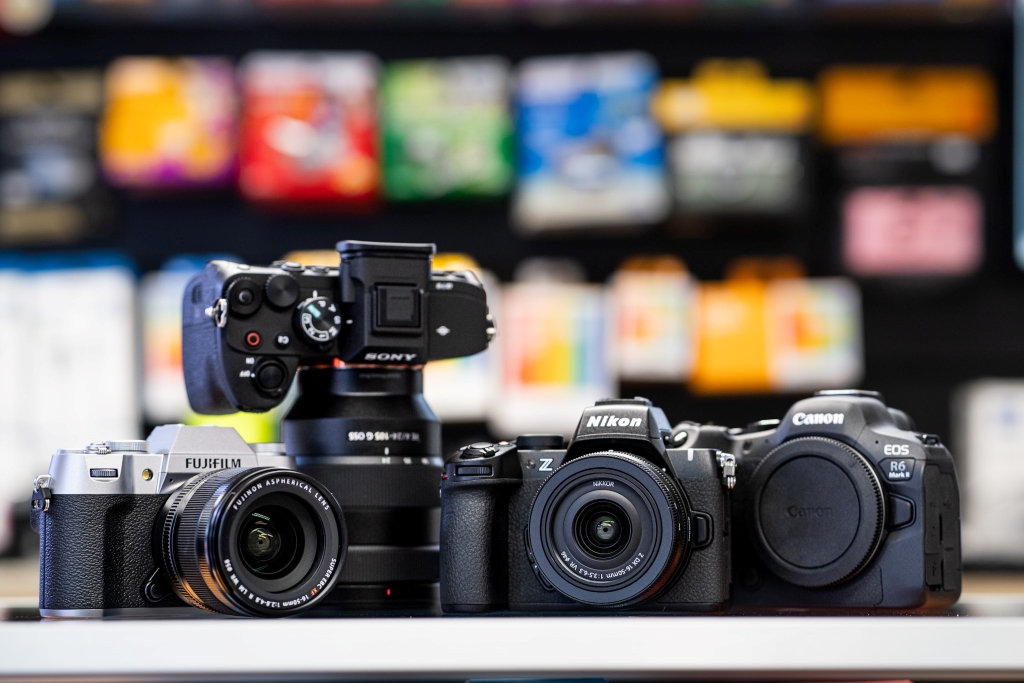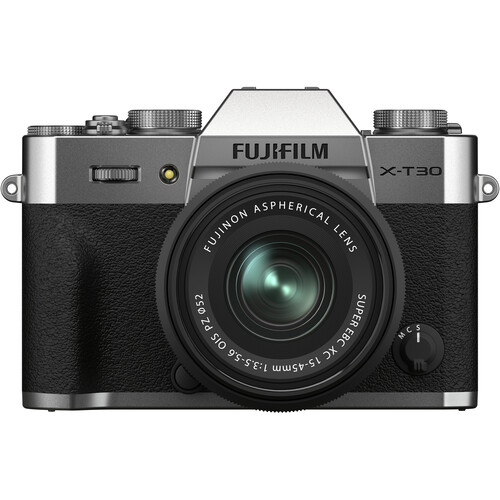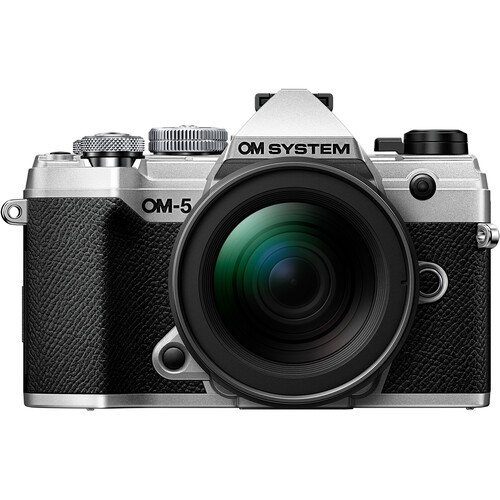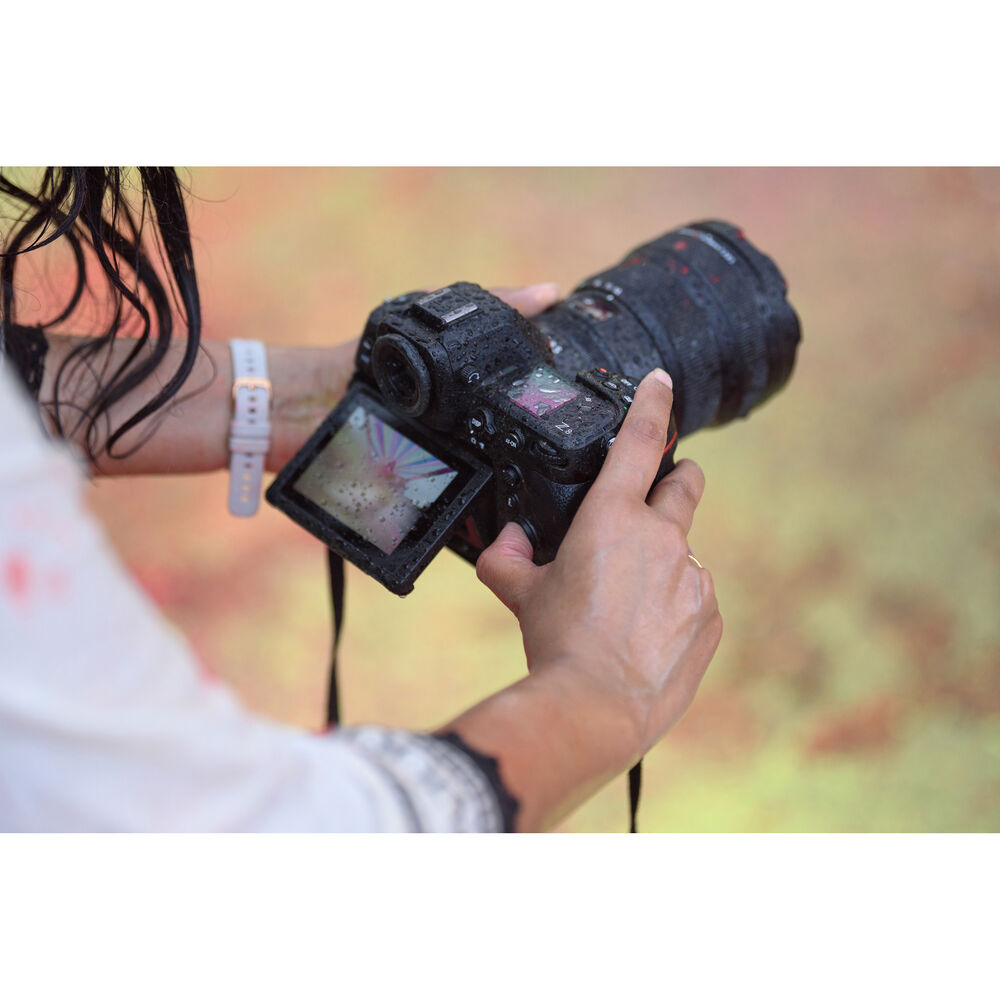
ITEMS £0.00
Browse by Brand
Atomos
Benro
Billingham
Binoculars and Telescopes
BlackRapid
Canon
Celestron
DJI Drones
DJI Osmo
Fujifilm GFX
Fujifilm X Series
Gitzo
GPO
Hahnel
Insta360
Joby
Lee Filters
Leica
Leica Sport Optics
Leofoto
LowePro
MagMod
Manfrotto
Maplin
Mindshift
NatureCams
Nikon
Olympus
Panasonic
Peak Design
Rode
Rotolight
Samyang
Sigma
Sony
Tamron
Tenba
thinkTANK
Vanguard
Zeiss Lenses
Zhiyun
A Buying Guide to Mirrorless Cameras
In the world of photography, mirrorless cameras have seen a surge in popularity in recent years. They have revolutionised digital cameras, bringing innovative design and functionality with boundless creative potential. Mirrorless digital cameras emerge as the ideal solution for photographers who seek a compact, lightweight design that doesn't sacrifice performance.
In this buying guide to mirrorless cameras, we'll cover everything from its advantages over traditional DSLRs to buying mirrorless camera systems based on your unique needs and budget.

A mirrorless camera is a type of digital camera without the reflex mirror found in digital SLR cameras. This allows for a more compact and lightweight design. Unlike digital SLRs, which use a mirror mechanism to reflect light into an optical viewfinder, a mirrorless camera system directs light straight to its image sensor. This provides a real-time digital preview through an electronic viewfinder (EVF) or LCD screen.
The architecture of mirrorless cameras also allows for faster shooting and silent operation. It also features intelligent autofocus systems, allowing you to capture high-resolution images as well as film in 4K resolution. As the technology continues to advance, mirrorless digital cameras will only become more sophisticated.
Types of Mirrorless Cameras
Mirrorless cameras support a wide range of shooting styles and preferences, designed to meet specific needs and creative pursuits:
Full-frame mirrorless cameras are ideal for professionals seeking high image quality and performance in low-light scenarios. They are perfect for landscape or portrait photography due to their large sensors.
APS-C mirrorless cameras feature smaller sensors than full-frame mirrorless cameras. They are often more affordable and compact, making them suitable for travel photographers or hobbyists.
Medium-format cameras, with even larger sensors than full-frame, offer professional-grade detail for studio or fashion photography.
For beginners, entry-level mirrorless cameras provide an excellent start to your photography journey with user-friendly features.
Vloggers may prefer hybrid or dedicated vlog mirrorless cameras, which offer excellent video recording capabilities. They also come with handy features such as flip-out screens, high-quality microphone input and live streaming.

- Mirrorless cameras offer a smaller, lighter design compared to DSLRs. They are easier to carry for extended shooting sessions or travel.
- Mirrorless systems often feature advanced autofocus, including hybrid systems that combine phase-detection and contrast-detection autofocus. This allows for faster and more reliable focus when shooting.
- These digital cameras are also equipped with subject tracking features, like face and eye detection, which enable them to lock focus on moving subjects. This is particularly useful for sports, action or wildlife photography.
- The EVF (electronic viewfinder) in mirrorless camera systems offers a real-time digital preview of your shot, allowing for precise adjustments before capturing the image.
- Many mirrorless cameras support 4K video recording, making them ideal for videographers and vloggers seeking excellent video performance.
- With the absence of a mirror mechanism, these cameras offer the advantage of quiet operation, ideal for discreetly capturing moments and elusive wildlife.
- A wide range of lenses is available for mirrorless systems, giving photographers flexibility across various photography styles.
Which Mirrorless Camera Should I Buy?
Below are some considerations to help you choose the right mirrorless camera that aligns with your photographic needs and budget.
Key Features to Consider
One of the key features to consider in a mirrorless camera is its size and weight, especially for shooting in challenging environments. Lens compatibility is another important factor, as it gives you more shooting options. Ensure the mirrorless camera you buy supports a range of lenses for your style of shooting.
Image stabilisation is an essential feature for reducing camera shake, enabling sharper images in low-light conditions or when using telephoto lenses. Also, consider battery life, particularly if you plan to shoot extensively or for remote assignments.
Budget Considerations
When choosing a mirrorless camera, your budget significantly impacts your options. Mirrorless systems come in different price ranges according to their features and capabilities. For those seeking budget-friendly options, consider mirrorless models like the Sony a6400 or Canon EOS R100, both offering impressive features for beginners at an affordable price point.


For professionals seeking high-end performance, the Sony A7R V or Canon EOS R5 Mark II, are top-tier choices, delivering exceptional image quality and advanced features, including expandable ISO ranges, high-speed continuous shooting, and dual card slots for more storage options.


When selecting a mirrorless camera, it can be helpful to understand the unique strengths each brand offers to help guide your purchasing decision.
Canon mirrorless cameras are well-known for their excellent colour science, producing rich skin tones and colours. They also come with intuitive touchscreen displays, like in the Canon R5, allowing for easy menu navigation and making fine adjustments before shooting. Canon's extensive range of lenses also adds versatility to their offerings.
Nikon mirrorless cameras are renowed for their rugged build quality and ergonomic design, making them ideal for photographers who value handling and durability. The Nikon’s Z mount system is the largest on the market and provides ultimate flexibility with a variety of high-quality lenses to choose from.
The Sony mirrorless camera range leads the mirrorless market, offering intelligent autofocus technology and exceptional low-light performance. They are perfect for sports, action and wildlife photography.
Other camera brands like Fujiflm and OM SYSTEM offer unique aesthetics and film simulation modes, cherished by those who appreciate a vintage look.


For those stepping into the world of photography, here are some of the best beginner-friendly mirrorless cameras:
The Sony a6400 is known for its fast autofocus and compact design. This mirrorless camera is ideal for beginners looking to capture action shots with ease.
The Canon EOS R100 comes with an intuitive touchscreen display and excellent video capabilities, perfect for those interested in vlogging and still photography.
The Nikon Z50II features a compact design that combines excellent performance with impressive image quality, making it accessible for photographers, both beginners and professionals, to enjoy and appreciate their creative pursuits.
The Fujifilm X-T30 II offers a great balance of user-friendly controls and creative features, making it suitable for new photographers who are still exploring different shooting styles.

To enhance your photography experience, it often involves investing in essential camera accessories, whether you're looking to shoot distant subjects, stabilise images or video recordings, or protect your equipment. Camera accessories can help keep your mirrorless camera safe, as well as unlock its true potential, ensuring you capture every moment with precision and ease.
Camera Lenses
There are different types of camera lenses available, depending on your photography needs. For example, a prime lens is ideal for shooting portraits, while a wide-angle lens can capture detailed landscapes.
Tripods
A sturdy tripod is essential for shooting in low-light situations or long-exposure shots, helping to eliminate camera shake.
Memory Cards
High-speed memory cards ensure you can capture high-resolution images and videos without lag. They are indispensable for photographers shooting in burst mode or 4K video.
Camera Bags & Cases
A weather-proof camera bag and case protects your camera equipment from any damage and makes it easier to carry multiple items, keeping everything organised and accessible.
Maintenance and Care Tips for Mirrorless Cameras
Here are some essential tips for keeping your mirrorless camera in optimal condition:
- Use a soft, lint-free cloth to clean the camera body and lenses after use. A rocket blower can be used to remove dust from sensitive parts like the image sensor.
- Clean lenses with a microfibre cloth and lens cleaning solution to prevent scratches and smudges.
- Always attach lens caps when not in use. Consider getting protective filters on lenses to shield them from dirt and damage. A filter is much cheaper to replace compared to a lens.
- Invest in a camera bag or case to safeguard your equipment during transport.
- Protect your camera from extreme temperatures and humidity, as this can damage internal components. Consider buying weather-sealed mirrorless cameras, like the Canon EOS R5 Mark II, or Nikon Z6III, for shooting in challenging conditions or environments.
- Remove the battery if the mirrorless camera is stored for extended periods.





